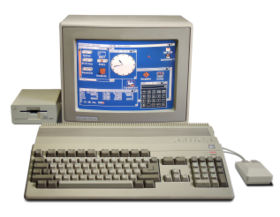
Quick Specs
CPU: Motorola MC68000 @ 7.09379 MHz (PAL)
RAM: 512K (expandable to 9MB)
OS: Workbench 1.2/1.3
Video: 320x256, 320x512, 640x256, 640x512
Input: Keyboard, Mouse, Joystick
Drives:
The Amiga A500, released in 1987, was Commodores first attempt at a low end Amiga 16/32-bit multimedia
home computer. It became Commodore's best selling Amiga model and was replaced in 1991 by an enhanced model
known as the A500 Plus.

I currently own three of these. Sadly without the kickstart disks Ive never actually been able to use an A500.
The best I can currently do is look at the monochrome insert disk screen. Two of the machines have A505 RAM/Clock
modules installed. To prevent damage the rechargable batteries have been removed from them meaning their clock
will probabily no longer functions. Should I manage to get a kickstart disk one day I will, with the help of some
diodes, attach a CR2032 battery holder in place of the rechargable batteries.
Hardware Information
Hardware information from Wikipedia
- Motorola 68000 microprocessor running at 7.15909 MHz in the NTSC version or 7.09379 MHz in the PAL version. While this was a 32-bit chip internally, it had a 16-bit data bus and 24-bit address bus, providing a maximum of 16 MB addressable space.
- OCS chipset. Later revisions of the chipset made PAL/NTSC mode switchable in software.
- Graphics could be of arbitrary dimensions, resolution and colour depth, even on the same screen.
- Without using overscan, the graphics could be 320 or 640 pixels wide by 200/256 or 400/512 pixels tall.
- Planar graphics were used, with up to 5 bitplanes (4 in hires), allowing 2, 4, 8, 16 and 32 colour screens, from a palette of 4096 colours. Two special graphics modes where also included: Extra HalfBrite, which used a 6th bitplane as a mask that halved the brightness of any colour seen, and Hold And Modify (HAM), which allowed all 4096 colours on screen at once.
- Sound was 4 hardware-mixed channels of 8-bit sound at up to 28 kHz. The hardware channels had independent volumes (65 levels) and sampling rates, and mixed down to two fully left and fully right stereo outputs. A software controllable low-pass audio filter was also included.
- 512 KB of Chip RAM.
- AmigaOS 1.2 or 1.3
- One double-density floppy disk drive was included, which was completely programmable and thus could read 720 KB IBM PC disks, 880 KB standard Amiga disks, and up to 984 KB with custom formatting (such as Klaus Deppich’s diskspare.device).
- Built in keyboard.
- A two-button mouse was included.
Connectors
- 50 Hz PAL and 60 Hz NTSC analogue RGB video output, provided on an Amiga-specific video connector. This could also be genlocked to an external video signal. An RF adapter was bundled with the machine to provide output on regular televisions.
- The analogue RGB output on a DB-23 pin can drive a signal at 15.75KHz HSync for standard Amiga video modes. This is not compatible with most VGA monitors. A Multisync monitor is required.
- Stereo phono connectors for audio.
- A standard RS-232 serial port.
- A parallel port.
- A floppy drive port, for daisy-chaining up to 3 extra floppy disk drives.
- Two Atari DE9 sockets for joysticks or mice.
Expansions
- Expansion ports were limited to a side expansion port and a trapdoor expansion on the underside of the machine. The casing could also be opened up (voiding the warranty), all chips were socketed rather than surface-mounted, so they could be replaced by hand.
- The CPU could be upgraded to a 68010 directly or to a 68020, 68030 or 68040 via the side expansion slot.
- The Chip RAM could be upgraded to 1 MB directly on the motherboard, provided a Fat Agnus chip was also installed to support it.
- Likewise, all the custom chips could be upgraded to the ECS chipset.
- 512 KB of Slow RAM or Trapdoor RAM could be added via the trapdoor expansion. Such upgrades usually also included a battery-backed clock.
- Up to 8 MB of Fast RAM could be added via the side expansion slot.
- Hard drive and other peripherals could be added via the side expansion slot.
- Several companies provided combined CPU, memory and hard drive upgrades, or provided chainable expansions, as there was only one side expansion slot.
- Expansions were configured automatically by AutoConfig software, so multiple pieces of hardware did not conflict with each other.
See Also/Links


